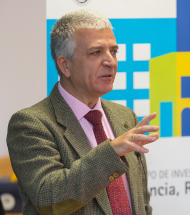Physicist Bernabé Linares-Barranco affirms at the University of Navarra that we are at the atomic limit of technology
The director of the Institute of Microelectronics of Seville participated in a seminar of the group 'Science, reason and faith' on Artificial Intelligence.

"Current technology is at the limits of atomic granularity, we cannot go beyond that," said physicist Bernabé Linares-Barranco, director of the Institute of Microelectronics of Seville, at the University of Navarra, on the occasion of his participation in the November seminar of group 'Science, Reason and Faith'.
The session focused on "Neuromorphic Computing and Nanotechnologies: How far could Artificial Intelligence go?". To put in context his statement about the atomic limit of technology, he recalled that there is currently a chip that is in many tablets and mobiles on the market, the Kirin from HiSillicon, "which is made in seven nanometers, measures less than one square centimeter, has almost seven billion transistors and is for image processing".
He stressed that we are witnessing a new resurgence of artificial intelligence, a term first used in 1956, motivated by the combination of knowledge in biological neuroscience, computational neuroscience, and the availability of better computational resources thanks to advances in nanotechnologies.
Throughout the session, he discussed how neuroscience knowledge can be combined with new nanotechnology techniques to build physical systems that "sense" and compute by mimicking the brain, in particular the vision system.
He explained that processing images computationally is very costly because there is a lot of information in each one of them, however, the "retinas" for cameras that high school Microelectrónica is researching, together with two other spin offs that are commercializing them, do it by means of motion recognition. The identification process is much faster, "impulse by impulse", resembling the process performed by the human eye when it perceives a reality.
He emphasized that this line of research, referred to by many as 'neuromorphic engineering or 'neuromorphic computing' "fits as a small but promising parcel within the current stream of the new resurgence of Artificial Intelligence".
Chips with the ability to function like neurons in the human brainBefore concluding the session, he posed whether at some point nanotechnology will be able to surpass the capacity of the human brain, stating that currently chips almost reach the functioning of neurons in the brain. "It's another thing to train them to do the same," he said.
Furthermore, although he assures that there are scientists who do not agree with him, he is sample not very optimistic about the possibility that "a machine will know that it has a self inside like a human being".
Bernabé Linares-Barranco is graduate in Electronic Physics from the University of Seville and holds a PhD from the same university and Texas A&M University. He has been Visiting Professor at Johns Hopkins University and Texas A&M University. He is currently director of the high school de Microelectrónica, a joint center of the University of Seville and committee Superior de Investigaciones Científicas.
